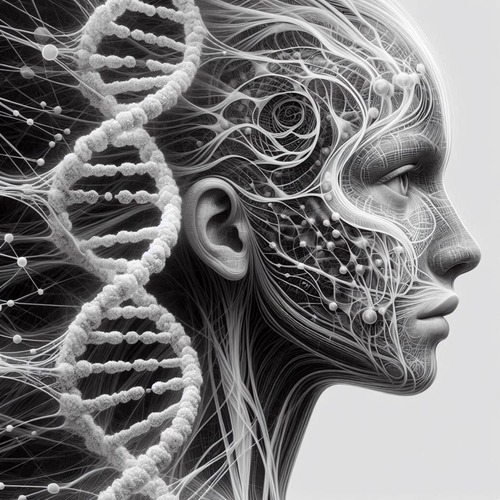DNA Evidence for Intelligent Design: New Challenges for Evolution
Each new discovery in genetic science appears to peel back a new layer of complexity in the DNA, revealing a fresh level of sophistication that defies naturalist explanations for its existence. This microscopic blueprint, carrying the instructions for all life, continues to baffle and inspire scientists with its unfathomable complexity and breathtaking efficiency. Recent breakthroughs in genetic research have not only expanded our understanding of this remarkable molecule but also fortified the argument for intelligent design. Join us as we examine how cutting-edge discoveries appear to indicate the fingerprints of the Creator—in the fabric of life itself
The Astounding Complexity of DNA: Surpassing Human Engineering
- Discovery: In 2022, researchers at the University of Cambridge created a groundbreaking and advanced 3D model of the human genome. The model revealed an even more intricate structure than it was hitherto assumed to have—showcasing how DNA folds and organises itself within the nucleus, with a level of complexity that surpasses our most advanced engineering feats.
- The highlight: The human genome’s newly revealed complexity, featuring precisely ordered 3 billion base pairs and intricate 3D organization surpasses our most advanced engineering. It presents a compelling case for intelligent design while challenging evolutionary explanations. This level of intricate organization, interdependent systems, and specified information content seems to exceed what random mutations and natural selection alone could produce.
- For details, search the University of Cambridge website
Information Theory and DNA: Complex, Like Computer Codes
- Discovery: A 2023 study published in the Journal of Theoretical Biology applied advanced information theory algorithms to analyse DNA sequences. The results showed the information content in DNA is far more complex than can be explained by natural selection and random mutations alone.
- The highlight: The 2023 study reveals a level of complexity and specificity in genetic information that bolsters the case for intelligent design. The information content found in DNA exhibits characteristics strikingly similar to those of human languages and sophisticated computer codes. This complexity goes beyond what can be reasonably attributed to natural selection and random mutations alone. The intricate, language-like structure of DNA facilitates storing and transmission of vast amounts of precise biological instructions.
- For details, explore articles on the intersection of information theory and biology, such as those found on academic databases such as PubMed.
Irreducible Complexity: The Interdependent Marvels of DNA
- Discovery: In 2024, researchers at the Max Planck Institute for Molecular Genetics identified new layers of complexity in DNA repair mechanisms. These findings reveal an intricate network of over 50 proteins working in concert to maintain genomic integrity, challenging evolutionary explanations.
- The highlight: The DNA replication and repair systems exemplify irreducible complexity, as proposed by Michael Behe. The interdependence of multiple components in these systems strongly suggests they were designed as complete, functional units from the start—rather than evolving in stages.
- Detailed findings are often published in journals such as Molecular Cell.
The Fine-Tuning of Genetic Codes: Precision Beyond Probability
- Discovery: A 2023 computational study published in Nature Communications has further confirmed the optimal nature of the genetic code. By simulating millions of possible genetic codes, researchers found the actual code used by life on Earth outperforms random codes by several orders of magnitude in terms of error minimisation and information transfer efficiency.
- The highlight: The extraordinary optimisation of the genetic code, capable of minimising errors and maximising information transfer, strongly implies intentional design rather than random processes.
- Source: Nature Communications
DNA as an Information Storage Powerhouse: Mimicking Divine Design
- Discovery: In a landmark 2023 experiment, scientists at Harvard University successfully stored and retrieved 1 exabyte (1 billion gigabytes) of data in a single gram of synthetic DNA. This achievement showcases DNA’s unparalleled data storage capacity, far surpassing any human-made technology.
- The highlight: The fact that human engineers are turning to DNA for data storage solutions underscores its superior design. This mirrors the efficiency of genetic information storage in living organisms, pointing to an intelligent source behind DNA’s origin.
- Source: Articles on this breakthrough can be found on Harvard University’s research news.
Epigenetics: The Hidden Layer of Genetic Brilliance
- Discovery: Epigenetics is an emerging topic of study that reveals how environmental factors, including our experiences in childhood, affect our genetic expression. Recent advancements in epigenetics have revealed an additional layer of complexity in DNA functionality. A 2024 study in Cell demonstrated how environmental factors can influence gene expression without altering the DNA sequence itself, through mechanisms such as DNA methylation and histone modification.
- The highlight: The existence of this sophisticated regulatory system, capable of adapting gene expression to environmental cues, adds another dimension to DNA’s complexity. This intricate interplay between genes and environment suggests a level of foresight and planning consistent within intelligent design.
- Source: Check out the detailed research articles at Cell
The Language of DNA: Sophistication that Suggests Intelligence
- Discovery: A groundbreaking 2023 study in Nature Genetics uncovered evidence of what researchers call the “silent language” of DNA. This research revealed non-coding regions of DNA, once dismissed as “junk,” play crucial roles in gene regulation and cellular processes through complex three-dimensional interactions.
- The highlight: The discovery of this hidden language within DNA further emphasizes its design-like qualities. The multi-layered, multi-dimensional nature of genetic information storage and communication points to a level of sophistication that strongly suggests an intelligent creator.
- Source: Explore more on this topic at Nature Genetics.
Conclusion: From its mind-bending intricacy and information-rich content to its irreducibly complex systems and fine-tuned efficiency, DNA bears the unmistakable hallmarks of purposeful creation. The mounting evidence from DNA research aligns remarkably with the concept of an intelligent designer that even sceptic scientists are finding difficult to ignore. As we continue to unravel the mysteries encoded in our genes, the evidence is before us; the implications are profound. DNA is proving to be not just the code of life, but the greatest revelation of our time—a bridge between science and faith, pointing to a deeper sense of our ultimate origin and purpose.
Related Reads:
Editor's Pick

Do Christians Need Holy Shrines? Why the Reformed Answer Is No
Walk into a medieval cathedral and you'll encounter ornate shrines, gilded reliquaries, and designated "holy places" where pilgrims gather to [...]

I Want To Believe, But Can’t: What Do I Do?
"I want to believe in God. I really do. But I just can't seem to make it happen. I've tried [...]

BC 1446 or 1250: When Did the Exodus Really Happen?
WHY REFORMED SCHOLARS SUPPORT THE EARLY DATE Many a critic makes the claim: “Archaeology has disproven the biblical account [...]

Does God Know the Future? All of It, Perfectly?
Think about this: our prayers tell on us. Every time we ask God for something, we’re confessing—often without realising it—what [...]

Can Christian Couples Choose Permanent Birth Control?
Consider Sarah, whose fourth pregnancy nearly killed her due to severe pre-eclampsia, leaving her hospitalised for months. Or David and [...]

Bone of My Bones: Why Eve Was Created From Adam’s Body
"This at last is bone of my bones and flesh of my flesh!" Adam's joyful exclamation upon first seeing Eve [...]

Is Calvinism Fatalism in Christian Disguise? Think Again
We hear the taunt every now and then: "Calvinism is just fatalism dressed up in Christian jargon." Critics argue Reformed [...]

Can Churches Conduct Same-Sex Weddings?
In an era of rapid cultural change, churches across America face mounting pressure to redefine their understanding of marriage. As [...]

Gender Reassignment: Can Christian Doctors Perform These Surgeries?
In the quiet of a clinic, a Christian physician faces a challenging ethical question. A patient sits across the desk, [...]

‘What Sorrow Awaits You Who Are Rich…’: What Does Jesus Mean?
The words hang in the air like a sword over comfortable Christianity: “What sorrow awaits you who are rich, for [...]
SUPPORT US:
Feel the Holy Spirit's gentle nudge to partner with us?
Donate Online:
Account Name: TRUTHS TO DIE FOR FOUNDATION
Account Number: 10243565459
Bank IFSC: IDFB0043391
Bank Name: IDFC FIRST BANK






